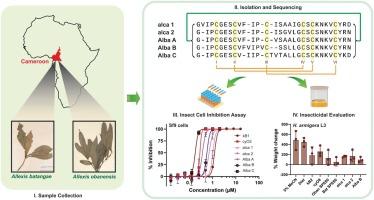Discovery of insecticidal cyclotides from the African plants Allexis batangae and Allexis obanensis
IF 6.2
1区 农林科学
Q1 AGRICULTURAL ENGINEERING
引用次数: 0
Abstract
Cyclotides are plant-derived cyclic peptides recognized for their crucial role in host defense against insects and fungal pathogens. They are characterized by an ultra-stable head-to-tail cyclic backbone and a cystine knot formed by three conserved disulfide bonds, and are considered to be a promising group of molecules for a diverse array of agricultural and pharmaceutical applications. Cyclotides have been identified in five major plant families, with the Violaceae being a particularly rich source. Although cyclotides are ubiquitous in the Violaceae, many genera within this family remain unexplored. In the current study, the presence of cyclotides in Allexis batangae and Allexis obanensis from the Allexis genus in the Violaceae family was investigated. Five bracelet cyclotides, including three novel cyclotides, Alba A-C, were isolated and characterized using MS-MS analysis and NMR spectroscopy. The cytotoxic activity of these cyclotides was evaluated against Spodoptera frugiperda (Sf9) insect cells and demonstrated high potency as insecticidal agents, with Alba C exhibiting the highest activity (CC50= 0.18 ± 0.02 µM). The insecticidal effect of the discovered cyclotides was further evaluated in a feeding study using Helicoverpa armigera L3 larvae. Both a plant extract and individual cyclotides effectively inhibited larval growth. The A. batangae extract showed the greatest effect, followed by Alba B and the A. obanensis extract, achieving approximately 70 % and 50 % greater inhibition than the known insecticidal cyclotide kalata B2. Moreover, ecotoxicological evaluation using Daphnia magna revealed no acute toxicity of the tested cyclotides, underscoring their safety for non-target aquatic organisms. These findings underscore the potential of cyclotides as potent bioinsecticide agents and highlight their promising applications in agricultural pest management.

非洲植物巴丹加和奥巴兰花中杀虫环核苷酸的发现
环肽是植物衍生的环状肽,在宿主防御昆虫和真菌病原体中起着至关重要的作用。它们的特点是具有超稳定的首尾环骨架和由三个保守的二硫键形成的胱氨酸结,被认为是一组有前景的分子,可用于多种农业和制药应用。在五个主要的植物科中已经发现了环聚糖,其中堇菜科是一个特别丰富的来源。虽然环藻在堇菜科中普遍存在,但这个科中的许多属仍未被发现。本研究对堇菜科堇菜属堇菜属的巴唐菖蒲和奥班菖蒲中环核苷酸的存在进行了研究。从5个环链化合物中分离得到3个新型环链化合物Alba A-C,并利用MS-MS和NMR对其进行了表征。结果表明,这些环肽对Spodoptera frugiperda (Sf9)昆虫细胞的毒活性较高,其中Alba C的毒活性最高(CC50= 0.18 ± 0.02 µM)。在对棉铃虫L3幼虫的取食研究中,进一步评价了所发现的环肽类杀虫剂的杀虫效果。植物提取物和单个环聚糖均能有效抑制幼虫的生长。巴丹加提取物的抑虫效果最好,其次是Alba B和A. obanensis提取物,其抑虫效果分别比已知杀虫环肽kalata B2高70 %和50 %。此外,利用大水蚤进行的生态毒理学评价显示,所测试的环聚糖没有急性毒性,强调了它们对非目标水生生物的安全性。这些发现强调了环聚糖作为强效生物杀虫剂的潜力,并强调了它们在农业病虫害管理中的应用前景。
本文章由计算机程序翻译,如有差异,请以英文原文为准。
求助全文
约1分钟内获得全文
求助全文
来源期刊

Industrial Crops and Products
农林科学-农业工程
CiteScore
9.50
自引率
8.50%
发文量
1518
审稿时长
43 days
期刊介绍:
Industrial Crops and Products is an International Journal publishing academic and industrial research on industrial (defined as non-food/non-feed) crops and products. Papers concern both crop-oriented and bio-based materials from crops-oriented research, and should be of interest to an international audience, hypothesis driven, and where comparisons are made statistics performed.
 求助内容:
求助内容: 应助结果提醒方式:
应助结果提醒方式:


